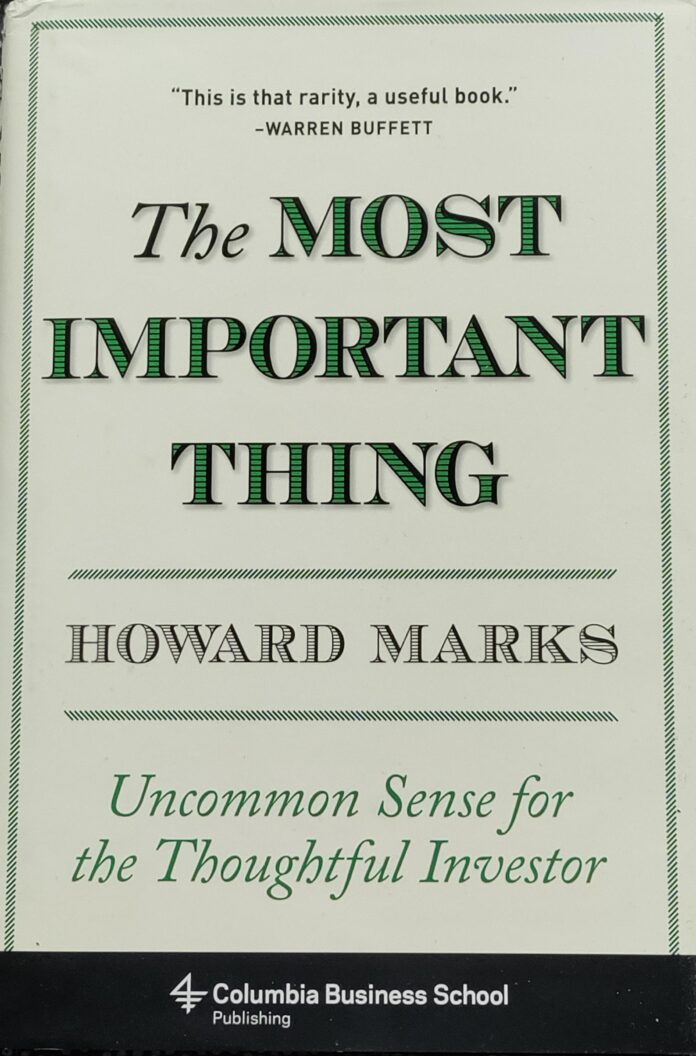The Most Important Thing – Uncommon Sense for the Thoughtful Investor is written by the cofounder of Oaktree Capital Management and one of the giants of the financial world, Howard Marks.
In his book, Marks offers countless valuable lessons about successful long-term investing that I guarantee are of use to all investors.
Here I’ve gathered some of the things I found to be most useful.
Obviously, the book is filled with other concepts that are at least as important as the ones I picked.
I merely figured it was not the wisest idea to write the book again, so I picked the ones that were most interesting and applicable to everyone.
Second-Level Thinking
In the first chapter, Marks introduces us to second-level thinking, which is a name for a deeper, more perceptive level of critical thinking. While there are many separate aspects that make a successful investor, I believe this is the most important one.
The idea is that most investors don’t utilize this way of thinking, and therefore achieve inferior results. The investors that are capable of second-level thinking are more likely to succeed as investors.
As I interpret it, it’s pretty much the same as the idea of system 1 and system 2 that Daniel Kahneman had in his classic book Thinking Fast and Slow.
The idea is that our brains form thoughts in two different ways or systems. The first-level thinking (system 1) is fast, simplistic, and superficial. The second-level thinking (system 2), on the other hand, is slower, deeper, and more complex.
What this all means is that we tend to make decisions based on hunches and first glances, without considering them thoroughly from all possible angles.
In investing, this leads to hasty and careless decisions that may lead to undesirable results. That can all be avoided, if the investor is capable of second-level thinking.
Understanding Market Efficiency
Ah, yes. The age-old argument about whether the stock market is efficient or not.
If you’re not familiar with the efficient market hypothesis, it’s basically a theory that suggests that stock market prices already reflect all information available.
This would mean that the stocks are always priced correctly and buying undervalued stocks to make higher returns would be impossible.
The way Marks sees it is that the stock market is efficient in incorporating information, but it doesn’t always incorporate it correctly.
What this means is that the stock market quickly forms a consensus of a stock price, but it’s not necessarily a correct price.
An investor with second-level thinking skills can use this to her advantage and benefit from buying mispriced stocks.
Value and Price
One of the key ideas in the relationship between a stock’s value and price is that the stock price doesn’t always reflect the intrinsic or “real” value of the stock.
Therefore, if you find a stock that you think is worth a lot more than its current price, it’s possible to make high returns by buying it at a low price.
This whole concept is pretty much what value investing is based on.
It’s worth remembering, though, that calculating a stock’s intrinsic value correctly isn’t an easy thing to do. Having an incorrect opinion of a stock’s intrinsic value and holding it firmly can be devastating to your portfolio.
Also, you might be entirely correct in your analysis, but it can take a long, long time for the stock market to realize it. There’s an old saying that states that the market can stay irrational much longer than you can stay solvent.
Market Cycles
Marks has actually written an entire book about this subject called Mastering the Market Cycle. I read it right after The Most Important Thing and found it complementing this one really well.
The bottom line in dealing with market cycles is figuring out where you are at the current market cycle and using it to your benefit.
The rule of thumb is that expected returns are highest at the bottom of each cycle and get lower as the cycle nears its peak.
Unfortunately, predicting market cycles is extremely difficult, which is why it’s best to focus on defining your place in the current market cycle.
Both at the bottom and at the top, investors tend to forget that cycles exist. When things are good, investors expect them to stay that way forever, and vice versa.
This offers great opportunities for rational investors who are able to hold on to their cash long enough.
Stock Market as a Pendulum
One of the ideas that really got to me was viewing the stock market as a pendulum.
On both extreme ends, there are endless exuberance and bottomless despair. At the center is the neutral zone where stocks are priced “correctly”.
Now, the pendulum swings from one end to the other on a regular basis, but it can’t stay in either extreme forever. Eventually, the pendulum swings to the opposite direction.
In stock market terms, the market moves between the depths of a bear market and the highest peak of a bull market, spending only a little time at the center.
So, most of the time, stocks are either undervalued or overvalued.
Negative Influences
As I’ve stated many, many times before, investing is mostly about psychology. For long-term investors, human nature is often the greatest obstacle to overcome.
Marks has listed six tendencies of human nature that a successful investor has to control and overcome. These are:
– Greed
– Fear
– Tendency to dismiss logic, history, and time-honored norms.
– Tendency to conform to the view of the herd.
– Envy
– Ego
– Capitulation (the tendency to buy high and sell low)
The most important thing (pun intended) for an investor is to recognize and accept these urges and develop the mental strength to resist them.
It also helps to be realistic. No matter what your investment strategy is, no one is immune to their basic nature, which is why it’s essential to stay honest with yourself.
Contrarianism
According to Marks, most investors are trend followers. Superior investors, on the other hand, are contrarians.
So, as the market pendulum is at the extreme ends, one should act the opposite. In other (rather worn-out) words: buy low and sell high.
Only if making a successful investment would be that easy. The problem in all this is that contrarianism requires second-level thinking that very few investors possess.
Not only do you have to be right when you take a contrarian approach, but you also have to have the guts to go against the current and stay there. Speaking from experience, this can be mentally excruciating.
The hardest part isn’t going against the current, it’s dealing with the uncertainty. There’s always the chance that you’re wrong and everyone else is right.
As Marks puts it, the best investments are usually contrarian, challenging, and uncomfortable.
Defensive Investing
I sincerely wish I had read this chapter when I started investing.
For a long, long time my main goal as an investor was to find stocks that would appreciate in value and thus be labelled as “winners”. The problem was that I also ended up owning a lot of losers that ate a lot (or occasionally all) of the returns from the winning stocks.
As Marks points out, investing is balancing between finding the winners and avoiding the losers. More often than not, you get the best results by focusing on avoiding the losers instead of searching for winners.
Being a defensive investor isn’t about not seeking the winners and giving up higher returns, it’s achieving those high returns by avoiding the losing stocks.
A defensive investor also aims to keep losses at a minimum during stock market crashes and bear markets. This is usually achieved with diversification and operating with minimal or no leverage.
Adding Value
Marks’s investment philosophy is that the goal of active investing is to beat the market. Interestingly enough, he doesn’t consider investing in passive index funds as investing, per se.
The reason is that by investing in passive index funds you get the average market return, and investing is all about doing better than the average.
In other words, to add value is to beat the market with superior investing skills, such as applying second-level thinking.
An interesting note is that having superior investing skills and beating the market are two different things. It’s not only about the returns but also about the risk.
For example, an aggressive investor who makes a lot of returns when the market goes up, but also loses a lot when the market goes down, can’t be considered as a skillful investor.
Neither can a defensive investor who doesn’t lose much during bear markets but doesn’t make much returns either during bull markets.
Therefore, a skillful aggressive investor not only gains high returns during bull markets but also manages to limit his losses during bear markets.
The same can be said about a defensive investor who doesn’t lose a lot of money during bear markets but manages to make considerable returns during bull markets.




